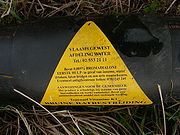
4-Hydroxycoumarins
Encyclopedia

Vitamin K antagonist
Vitamin K antagonists are a class of anticoagulants. They reduce blood clotting by inhibiting the recycling of vitamin K epoxide back to the active reduced form of vitamin K. The term Vitamin K antagonists is a misnomer. These drugs do NOT antagonize the action of Vitamin K...
(VKA) anticoagulant drug molecules derived from coumarin
Coumarin
Coumarin is a fragrant chemical compound in the benzopyrone chemical class, found in many plants, notably in high concentration in the tonka bean , vanilla grass , sweet woodruff , mullein , sweet grass , cassia cinnamon and sweet clover...
(chromen-2-one) by adding a hydroxy
Hydroxyl
A hydroxyl is a chemical group containing an oxygen atom covalently bonded with a hydrogen atom. In inorganic chemistry, the hydroxyl group is known as the hydroxide ion, and scientists and reference works generally use these different terms though they refer to the same chemical structure in...
group at the 4 position to obtain "4-hydroxycoumarin" (or "4-hydroxychromen-2-one"; formally then renumbered as 2-hydroxychromen-4-one), then adding a large aromatic substituent at the 3-position (the ring-carbon between the hydroxyl and the carbonyl). The large 3-position substituent is required for anticoagulant activity.
Although 4-hydroxycoumarin itself is not an anticoagulant, it is an important fungal metabolite from the precursor coumarin
Coumarin
Coumarin is a fragrant chemical compound in the benzopyrone chemical class, found in many plants, notably in high concentration in the tonka bean , vanilla grass , sweet woodruff , mullein , sweet grass , cassia cinnamon and sweet clover...
(also not an anticoagulant), and its production leads to further fermentative production of the natural anticoagulant dicoumarol. This happens in the presence of naturally occurring formaldehyde
Formaldehyde
Formaldehyde is an organic compound with the formula CH2O. It is the simplest aldehyde, hence its systematic name methanal.Formaldehyde is a colorless gas with a characteristic pungent odor. It is an important precursor to many other chemical compounds, especially for polymers...
, which allows attachment of a second 4-hydroxycoumarin molecule through the linking carbon of the formaldehyde, to the 3-position of the first 4-hydroxycoumarin molecule, to give the semi-dimer the motif of the drug class. Dicoumarol appears in spoiled sweet clover silages and is considered to be a fermentation product and mycotoxin
Mycotoxin
A mycotoxin is a toxic secondary metabolite produced by organisms of the fungus kingdom, commonly known as molds. The term ‘mycotoxin’ is usually reserved for the toxic chemical products produced by fungi that readily colonize crops...
. After its identification in 1940, it became the historical prototype of this drug class.
The synthetic drugs in the 4-hydroxycoumarin class are all noted primarily for their use as anticoagulants, though they can have several additional effects. All affect the normal metabolism of vitamin K
Vitamin K
Vitamin K is a group of structurally similar, fat soluble vitamins that are needed for the posttranslational modification of certain proteins required for blood coagulation and in metabolic pathways in bone and other tissue. They are 2-methyl-1,4-naphthoquinone derivatives...
in the body by inhibiting the enzyme vitamin K epoxide reductase
Vitamin K epoxide reductase
Vitamin K epoxide reductase is an enzyme that reduces vitamin K after it has been oxidised in the carboxylation of glutamic acid. Its C1 subunit is the target of anticoagulant warfarin.- See also :* Oxidoreductase...
which recycles vitamin K to active form. As such, these compounds form the most important and widely used subset of vitamin K antagonist
Vitamin K antagonist
Vitamin K antagonists are a class of anticoagulants. They reduce blood clotting by inhibiting the recycling of vitamin K epoxide back to the active reduced form of vitamin K. The term Vitamin K antagonists is a misnomer. These drugs do NOT antagonize the action of Vitamin K...
drugs, but other such drugs exist which do not have the 4-hydroxycoumarin structure. All the vitamin K antagonist agents diminish the amount of available vitamin K in the body, and thus inhibit the action of vitamin K-dependent enzymes that are critically involved in the production of active forms of certain clotting factors, and certain other metabolic processes involving the binding of calcium
Calcium
Calcium is the chemical element with the symbol Ca and atomic number 20. It has an atomic mass of 40.078 amu. Calcium is a soft gray alkaline earth metal, and is the fifth-most-abundant element by mass in the Earth's crust...
ion.
The simplest synthetic molecule in the 4-hydroxycoumarin class is warfarin
Warfarin
Warfarin is an anticoagulant. It is most likely to be the drug popularly referred to as a "blood thinner," yet this is a misnomer, since it does not affect the thickness or viscosity of blood...
, in which the aromatic 3-position substituent is a simple phenyl group. So called "super-warfarins" or second-generation anticoagulants in this class, were developed as rodenticides for rodents that have developed warfarin resistance. The second generation agents have even larger lipid-soluble substituents at the 3-position (e.g. brodifacoum
Brodifacoum
Brodifacoum is a highly lethal vitamin K antagonist anticoagulant poison. In recent years, it has become one of the world's most widely used pesticides...
), a chemical change that causes their half life in the body to be greatly increased (sometimes to months). The antirodenticide chemicals are sometimes incorrectly referred to as "coumadins" rather than 4-hydroxycoumarins (Coumadin® is a brandname for warfarin
Warfarin
Warfarin is an anticoagulant. It is most likely to be the drug popularly referred to as a "blood thinner," yet this is a misnomer, since it does not affect the thickness or viscosity of blood...
). They are also referred to as "coumarins," in reference to their derivation, although this term also may be deceptive since coumarin
Coumarin
Coumarin is a fragrant chemical compound in the benzopyrone chemical class, found in many plants, notably in high concentration in the tonka bean , vanilla grass , sweet woodruff , mullein , sweet grass , cassia cinnamon and sweet clover...
itself, as noted, is not active in clotting, and is used mostly as a perfumery agent.




- acenocoumarolAcenocoumarolAcenocoumarol is an anticoagulant that functions as a vitamin K antagonist . It is a derivative of coumarin and is marketed under the brand names Sintrom and Sinthrome.- Dosage :...
- dicumarolDicumarolDicoumarol or dicumarol is an anticoagulant that functions as a vitamin K antagonist . It is also used in biochemical experiments as an inhibitor of reductases....
- ethyl biscoumacetateEthyl biscoumacetateEthyl biscoumacetate is a vitamin K antagonist.- References :* The Merck Index, 12th Edition. 3818...
- phenprocoumonPhenprocoumonPhenprocoumon is an anticoagulant drug, a derivative of coumarin. It is a vitamin K antagonist that inhibits coagulation by blocking synthesis of coagulation factors II, VII, IX and X...
- warfarinWarfarinWarfarin is an anticoagulant. It is most likely to be the drug popularly referred to as a "blood thinner," yet this is a misnomer, since it does not affect the thickness or viscosity of blood...
Compounds in this class have also been used as pesticides, specifically rodenticides. They act by causing the affected animal to hemorrhage, causing it to seek water, and thus leave dwellings to die outdoors.
The second-generation vitamin K antagonist
Vitamin K antagonist
Vitamin K antagonists are a class of anticoagulants. They reduce blood clotting by inhibiting the recycling of vitamin K epoxide back to the active reduced form of vitamin K. The term Vitamin K antagonists is a misnomer. These drugs do NOT antagonize the action of Vitamin K...
agents, used only in this fashion as poisons (because their duration of action is too long to be used as pharmaceuticals) include:
- coumatetralylCoumatetralylCoumatetralyl is an anticoagulant of the warfarin type. Symptoms of overexposure relate to failure of the blood clotting mechanism and include bleeding gums and failure of blood clotting after skin wounds. After one exposure the toxicity of coumatetralyl is relatively low, however if overexposure...
- difenacoumDifenacoumDifenacoum is a coumarin derivative. It has anticoagulant effects and is used as a rodenticide.-Uses:Difenacoum is sold as blue-green pellets intended to be ingested by pests such as rats and mice.-Safety and toxicity:...
- flocoumafenFlocoumafenFlocoumafen is a second generation anticoagulant used as a rodenticide. It has a very high toxicity and is restricted to indoor use and sewers . This restriction is mainly due to the increased risk to non-target species. Studies have shown that rodents resistant to first generation anticoagulants,...
- bromadioloneBromadioloneBromadiolone is a potent rodenticide. It is a second-generation 4-hydroxycoumarin derivative, often called a "super-warfarin" for its added potency and tendency to accumulate in the liver of the poisoned organism...
- coumatetralylCoumatetralylCoumatetralyl is an anticoagulant of the warfarin type. Symptoms of overexposure relate to failure of the blood clotting mechanism and include bleeding gums and failure of blood clotting after skin wounds. After one exposure the toxicity of coumatetralyl is relatively low, however if overexposure...
- tioclomarolTioclomarolTioclomarol is a vitamin K antagonist....
- brodifacoumBrodifacoumBrodifacoum is a highly lethal vitamin K antagonist anticoagulant poison. In recent years, it has become one of the world's most widely used pesticides...
("d-Con" etc.)

